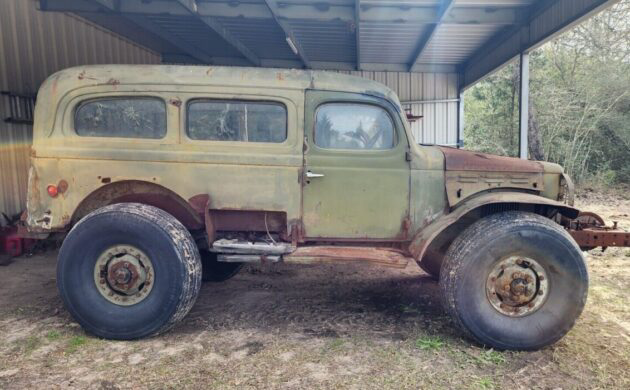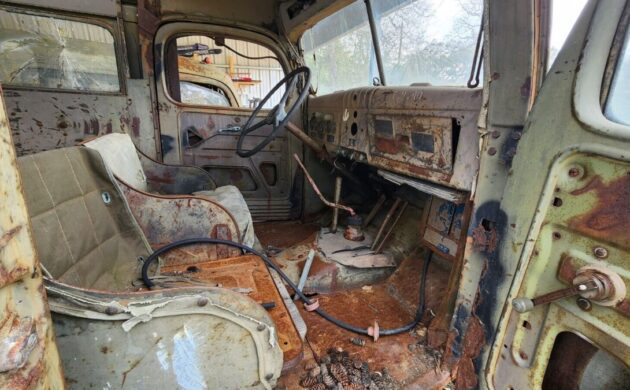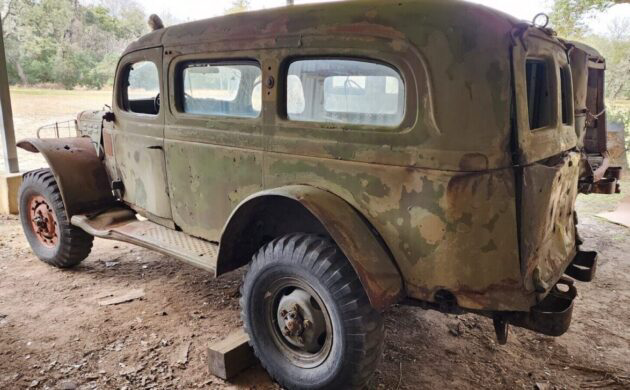If you’re having trouble finding a gift for that someone who already has everything, how about a pair of 1942 Dodge WC-53s? They were used by the Army during World War II and eventually found their way to Alaska. The seller bought three of them together, is restoring one, and making the other two available separately or as a package deal. Located in Inez, Texas, and available here on eBay, you can take one home for $9,000, both for $16,000 or – if you have to have them right away – do the Buy It Now option and spring for $18,000.
In the early 1940s, U.S. vehicle production for public consumption was put on hiatus for the war effort. Facilities were retooled to produce almost anything that might be needed to do battle in Europe or the Pacific. One of Dodge’s contributions was the ¾-ton, 4WD, WC-53 which was produced as either a Field Sedan or a Carryall. They were based on the WC51-52 Weapons Carrier Truck also made by Dodge. We understand these vehicles were intended for use by officers and other top brass rather than for more routine purposes such as ambulances. The Field Sedan and the Carryall were differentiated by side-hinged vs. top-hinged rear doors and their interior setups.
Only about 8,400 of them were built in 1942 and 1943 before production was discontinued. They were top-heavy vehicles that didn’t work well for cross-country use and were often targets of enemy aircraft. The two the seller has for sale found work after the War in what would eventually become the 49th U.S. State. After locating a trio to bring back to Texas, the seller may have borrowed what he/she needed from two of them and is restoring the third. So, the remaining pair is offered to someone else to revive. They have names, “Fat Tires” and “Little Boy.”
“Fat Tires” was prepared for use in the Yukon with the addition of large airplane tires for trekking through the snow. As such, the suspension was also modified, a larger transfer case was added, and a PTO winch was installed for good measure. We’re told the truck was running as recently as two years ago, but the 230 cubic inch engine is now stuck. Combat wheels are in place with both trucks. Like its companion, “Little Boy” needs a lot of bodywork but has a mostly solid and straight frame. We assume most of what you might need is there to get these going, but that’s just a guess. Would you buy both and work toward making one good truck out of two?











DON’T strip one for the other. With so few around they should both be restored . There’s a place in Indio CA for instance (https://www.rough-readydpw.com/) that has parts for these as well as other rigs.
History lesson time, Rw, spit that gum out, don’t make me get the ruler,,,,Alaska/Power Wagon/WW2, can only mean one thing, the Alaska Highway.( Later, Al-Can) Briefly, in case you’ve never heard of how that began,( feel free to correct) during the onset of the war, Japan bombed a part of the Aleutian Islands, causing over 100 casualties, it was thought there could be an invasion through Alaska, and the army built this incredible passage through areas that no person had gone before. You can look it up, but what they did was nothing short of a miracle, and Power Wagons, of all kinds, led the charge. All for naught, but did eventually connect Alaska to the states. These no doubt, had something to do with it, as I read, dozens of these were abandoned when the job was over.
Nothing fancy here folks, and probably $9grand in transportation costs, just a couple old Power Wagons, is all. I’ll salute these old soldiers, and the guys that operated them. Sorry ladies, very few women dozer operators then. They were part of our freedom, and while on the cushy end of the war, important none the less.
Well said guys.
Japan initiated the bombing of the Aleutian Islands to draw our fleet to assist, which would have left Midway Island open. Our intelligence folks caught on to the ruse and did not respond to assist.
That one move cost Japan 4 aircraft carriers and we took Midway Island.
That part I learned before, Howard A, I had no idea of the rest of the story (said in my best Paul Harvey voice)…Thank-you!
Hi Dave, and now you know the rest of the story,,,,good day,,
If I may add to your post Howard, and say that it connects Alaska to the rest of the states through the Yukon Territory and British Columbia in Canada, with mile 0 being at Dawson Creek when heading North starting in BC… It’s an amazing drive made even more amazing that the 1600 miles it traverses is through mostly inhospitable terrain and was completed in a little over 8 months… The history is worth reading and if you ever get the opportunity to drive it, take it, I know I was in awe when I traveled it both ways…sorry to hijack your post!
The Alaska Highway was quite a project. The idea was to build a highway that could connect Continental USA with Alaska and be able to have a land-based route. Conditions were horrible at best. If they weren’t fighting perma-frost and muskeg they were fighting muskeg and mosquitos. Then there was the cold–enough to make the brass monkeys take up hairdressing. They got the highway built and it is still in operation today. I understand that when everything was complete they just parked the bulldozers and the trucks, packed their bags and shipped out. Some bulldozers got sunk in the muskeg, leaving nothing but the exhaust pipe sticking out. Interesting enough, there have been a number of salvage operations gone back up there and hauled a lot of equipment out, even the Cats sunk in the muskeg. I heard stories that the muskeg is a perfect preservative; those Cats have been pulled out and when washed off, look as fresh as the day they rolled out of Peoria back in ’42.
I think anything we had that was seen would be targets of enemy aircraft , top heavy or not .
Don’t mean to be a stickler but these a WC series military vehicles not Power Wagons. The power wagon was not introduced till 46.
Thanks, Karl. Power Wagon is like “Jello” or “Kleenex”, as the WC kind of morphed into the Power Wagon, and all vintage units get called that. While Jeep gets all the attention, it was the WC/Power Wagon that really made a difference in our success.